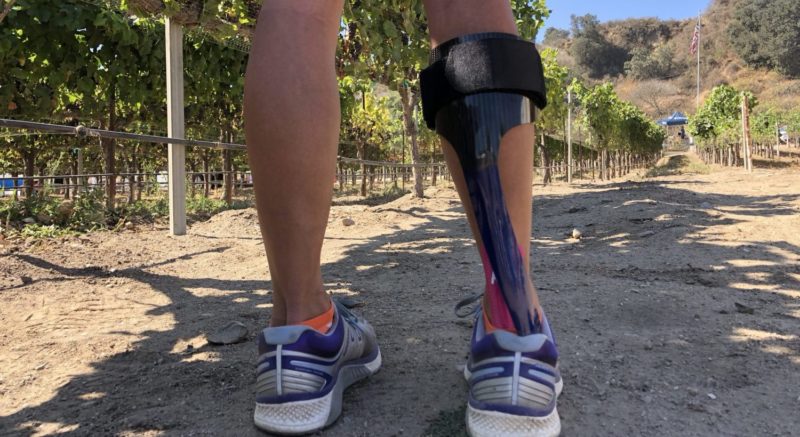Brace yourself: my ups and downs with AFOs
It was late May 2014, and my wife and I were on our first trip to the Cleveland Clinic. We’d been to Cleveland for a wedding a few years earlier but had been too busy to explore. We booked a room at the Tudor Arms, a cool, old hotel near the clinic’s Mellen Center for Multiple Sclerosis, hoping for a chance to look around.

SpryStep, my new dynamic AFO. Cheryl Hile
Mike Knight, Multiple Sclerosis News Today March 28, 2018
I had only recently received my ankle-foot orthosis (AFO) to compensate for my ever-worsening foot drop. Appropriately named the “BlueRocker,” the carbon composite AFO that was Velcro-strapped around my right calf had a support “rod” curling around my leg and a “springboard” fitting in below my right foot, under the sole insert in my shoe.
The demo unit I tried was pretty remarkable. Very light, and at the time, very effective at reciprocating the energy I was expending with each step. It reliably “rocked” my body weight through my stride, pushing my toes and foot upward into the correct position as I walked.
But I had barely used the AFO before our trip, for a few reasons. First, I hadn’t thought through how the brace might actually integrate into my life — how and when to use it. Devil, say hello to details. Over time, I learned that it worked well for me when I had straight, flat terrain. Steps, bumps, any sort of nuance or flexibility, not so much.
| AFO Pro Tip 1 |
| Don’t try and drive a car with a fixed-position AFO. |
Unless you want to accelerate very quickly and then brake in the same manner. I also found it challenging on stairs.
Second, I struggled to find shoes that comfortably accommodated the stiff, intrusive device.
I asked the orthotist who fitted me for a suggestion and she said to try larger shoes. Which I did. But the added weight and length made it harder to lift my foot, and I cheated by “swinging” my leg through as a result.
| AFO Pro Tip 2 |
| Running shoe companies often sell models designed to accommodate clunky, thick inserts that are similarly intrusive. |
Though sometimes expensive at $100 or more, they are light, durable, and occasionally cool looking.
By the time we got to Cleveland, we’d worked our way through those wrinkles. We spent the morning at the clinic and, with extra time on our hands and sunny, late spring weather, we decided to go for a walk.
Like a dog unleashed, I wanted to walk everywhere. We walked downtown and took in its architecture. We walked by the lake and by the Rock & Roll Hall of Fame. My guess is that we maybe walked 2 or 3 miles before my right leg simply wouldn’t lift any longer.
Four years later, I can no longer lift my foot high enough while wearing the AFO for it to clear the ground properly, increasing the likelihood of me catching the front of my foot and then toppling forward. So, I don’t use it anymore. I can still walk a short distance (maybe a few hundred feet) with little assistance, and then my right leg gets tired and my knee wants to snap and lock out backward — a freaky and untenable stride. I can still make a few trips up and down the stairs, but I can now barely — barely — walk around the block, even with my rollator walker.
Some of that is likely due to MS. Some of it is the dearth of walking I’ve done as it has become harder. Use it or lose it, right?
| AFO Pro Tip 3 |
| Like everything else with MS, I understand I have to push through and do things I don’t like doing to achieve a greater good. |
I’ll quickly admit that this may be my least favorite — and least followed AFO Pro Tip.
Not long ago, I met with my physical therapist to talk about what I can do to keep walking. She asked me to bring my AFO to my next appointment. “I can see why this isn’t working for you,” she said, pointing out that the brace’s design wasn’t doing me any favors when I presented it to her. I told her that the brace was the one that had been prescribed for me, presumably because somewhere along the line, someone thought it was the best solution for me.
Which leads me to…
| AFO Pro Tip 4 |
| There are a lot of AFOs out there, each providing varying levels of assistance. |
The trick, for me at least, has been finding the right person to recommend the right one, as my needs changed. Now my physical therapist and I are looking at alternatives.
And as I write this, I am wearing an in-home trial unit of a functional electronic stimulation (FES) device. I have it for two weeks. More — lots more — about it, soon.
Source Multiple Sclerosis News Today
| Multiple Sclerosis News Today is strictly a news and information website about the disease. It does not provide medical advice, diagnosis, or treatment. This content is not intended to be a substitute for professional medical advice, diagnosis, or treatment. |
| Always seek the advice of your physician or other qualified health provider with any questions you may have regarding a medical condition. Never disregard professional medical advice or delay in seeking it because of something you have read on this website. The opinions expressed in this column are not those of Multiple Sclerosis News Today or its parent company, BioNews Services, and are intended to spark discussion about issues pertaining to multiple sclerosis. |
Also see
SpryStep, My New Dynamic AFO Cheryl Hile
Braced for Running with Multiple Sclerosis Thuasne
